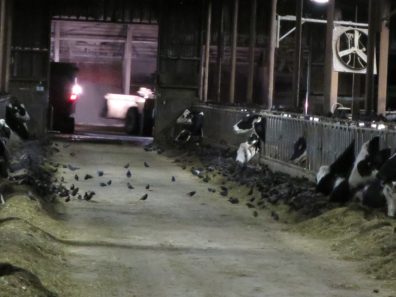Dairy Program Weekend at WSU
January 24 and 25, 2019
Please join us for WSU Dairy Program Weekend In Pullman. All events will be held in the Ensminger Pavilion, 455 Lincoln Dr.
On Friday January 24 and Saturday the 25 the annual CUDS review will occur with selected industry reviewers.
On Friday night, January 24, the WSU Dairy Club will host their annual Dairy Club Banquet (including a silent auction) from 5:30 – 8:00 PM. Please RSVP to savannah.crnick@wsu.edu for banquet reservations, cash will be accepted at the door.
On Saturday January 25, a CUDS reunion will be held beginning at 3 PM and concluding at 8 PM. Reservations (https://www.brownpapertickets.com/event/3918480) are required for the catered meal.
A block of rooms has been reserved at the Residence Inn (reservation link)
Please direct questions to Joe Harrison.
Joe Harrison, Livestock Nutrient Management Specialist, jhharrison@wsu.eduAmber’s Top Ten Tips: What We Learned About Pest Birds On Washington Dairies

Winter is the season for colder temperatures, holiday celebrations, and pest bird problems. Dairy barns attract more pest birds during the colder weather because they offer a warm shelter with plentiful food. The influx of pest birds on dairies results in lost feed from bird depredation, feed spoilage, building depreciation, increased costs for bird deterrence, and potentially negative consequences on cow well-being. Our Pest Bird Management Research Team conducted a survey and on-farm study over the last year to gain insight on the “big picture” of pest bird damage on Washington dairies. Here is a list of 10 things we learned:
-
Number of birds on dairies
During the peak of bird presence on dairies, 51% of surveyed farmers reported that 1,000 – 10,000 birds are present per day.
-
Birds that cause the most damage
European starlings, pigeons, and sparrows were the top three bird species that farmers identified as causing damage on Eastern Washington dairies. Western Washington dairies reported European starlings, pigeons, and crows were the top three damage-causing birds.
-
Popular bird deterrence methods
The three most popular bird deterrence methods used by surveyed farmers were shooting, netting, and trapping. However, 88% of the farmers that used shooting for bird deterrence considered the method to only be somewhat effective.
-
Alternative bird deterrence methods
Approximately 10% of surveyed farmers reported that the presence of predator birds (such as hawks and falcons) or the use of predator calls are alternative methods they use on their dairies to deter birds.
-
Johne’s disease and Salmonella
Dairies with more than 10,000 birds present per day were more likely to report the presence of Johne’s disease or Salmonella within their herds.
-
Salmonella, Escherichia coli (E. coli), and Campylobacter in bird feces
We collected fresh bird feces from the feed bunks of 16 pens (five different dairies) across Washington. Samples were analyzed for Salmonella, E. coli, and Campylobacter. Salmonella was not detected in any samples, but about 39% of the samples were positive for E. coli. Only one sample was positive for Campylobacter jejuni, bacteria linked to abortions in cattle.
-
Cow aggression at the feed bunk
We recorded cow and bird behaviors at the feed bunks of 16 pens (5 different dairies). As the number of birds at the feed bunk increased, cows showed more aggression toward the birds. This means that cows were spending more time displaying aggressive behaviors, interrupting their time spent eating.
-
Economics of feed loss due to bird depredation
Surveyed farmers reported losing an average of 4.4% of their feed to birds. This adds up to be about $14.7 million/year of losses.
-
Washington’s gross domestic product (GDP)
Our models predict that feed loss from bird depredation on dairies will result in a loss of 154 jobs and $12.6 million in Washington’s GDP over five years.
-
Birds deplete nutrients in cattle feed
Our team collected fresh feed samples from 19 pens (5 different dairies) to measure the net energy for lactation, total digestible nutrients, fat, crude fiber, ash, dry matter, and protein content. These samples represented the balanced diet formulated for the cows (what the cows were meant to eat). After the delivery of fresh feed, birds were allowed to eat at the feed bunk uninterrupted while the cows were being milked. After 30 minutes, we collected another sample of the feed from an area where birds had been eating. These samples represented the diet that was available to cows after bird depredation (what the cows actually get to eat). Our most shocking result was that farms lost up to 31% of net energy for lactation. This loss occurred after only 30 minutes of bird depredation!
We sure learned a lot over the last year, but we only scratched the surface of the problem. Our next steps are to test some alternative bird deterrence methods to determine which methods may be more economically feasible and long-lasting. Please contact us if you have any questions or ideas on how we can help dairy farmers manage this problem.
This project is funded by the Western Sustainable Agriculture Research and Education Program (Project # SW16-013). Our Pest Bird Management Research Team includes Stephanie Shwiff (USDA-APHIS), Karen Steensma (Trinity Western University), Susan Kerr (WSU), Julie Elser (USDA-APHIS), Tyler Caskin (WSU), and Amber Adams Progar (WSU).
Amber Adams Progar, Dairy Management Specialist, amber.adams-progar@wsu.eduRegister to Attend the 2019 Western Dairy Management Conference!
Monday, February 25 – Thursday, February 28, 2019
Peppermill Casino Resort Spa – Reno, NV
WDMC Early Bird Registration Deadline
February 1, 2019
Hotel Room Reservation Deadline
February 3, 2019
Complete Schedules and Registration Information for Meetings (CDBC and WDMC) and Hotel